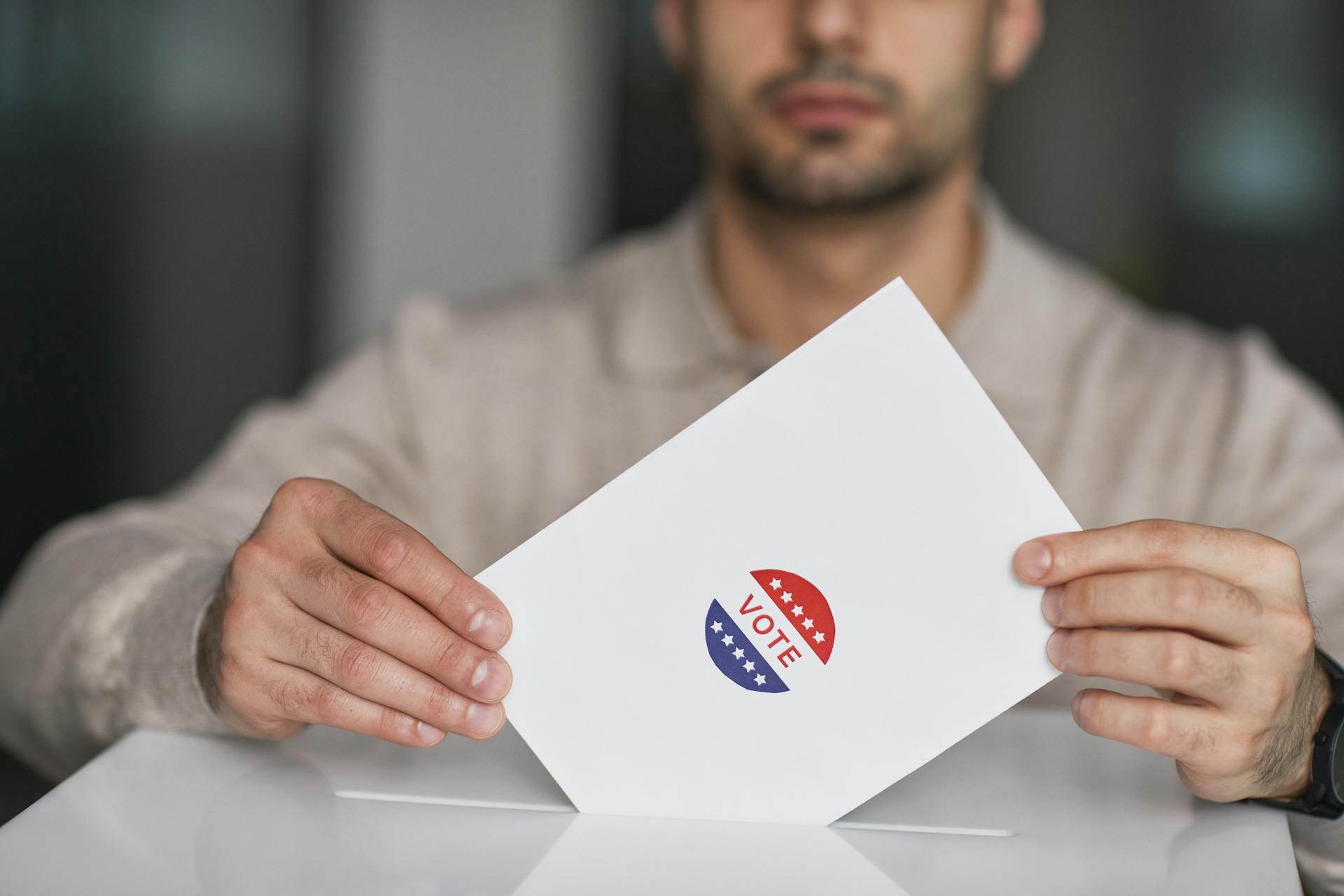
Super-voting stock structures are designed to give certain shareholders more control over a company than others.
Some companies, like Google and Facebook, use super-voting stock to give founders and early investors more voting power.
This can be beneficial for companies that want to maintain control and direction, but it can also be a disadvantage for other shareholders who may feel their voices are not being heard.
Super-voting stock can be used to protect the interests of certain shareholders, such as those who have invested in the company from its early stages.
For more insights, see: Super Fund
What is Super Voting Stock?
Super Voting Stock is a type of stock that gives its holder more voting power than regular stock.
It's typically issued to a company's founders, executives, or major shareholders, who use it to maintain control of the company.
Super Voting Stock can be issued in various forms, including Class B stock or other special classes of stock with enhanced voting rights.
For example, Google's founders held Super Voting Stock that gave them 10 times the voting power of regular stockholders.
This allows them to maintain significant control over the company's decision-making process.
Curious to learn more? Check out: Class S Shares
Types of Stock

In a super-voting stock structure, the ratio for super-voting stock is normally 10 votes per share, although the number of votes can vary.
Companies that have selected the dual-class structure have risen over recent years.
Companies like Snapchat, Facebook, and Google have also utilized such a structure.
The founders can easily keep good control over the company as they give out equity to investors and employees.
You might like: What Are Super Apps
Rationale and Criticism
Google's founders, Larry Page and Sergey Brin, used the example of media companies to justify dual share classes, citing their ability to focus on long-term innovation without short-term commercial pressures.
This notion was likely influenced by Apple's history, where founder Steve Jobs' departure led to the company's struggles, only to mount a historic comeback after his return in 1997.
Investors in IPOs tend to be optimistic about founders' abilities, and since share classes are disclosed in IPO prospectuses, investors are presumably making informed decisions.
Here's an interesting read: S B I Card Share Price
Critics, however, argue that dual share classes entrench unaccountable founders and expose other shareholders to increased risk of self-dealing and abuse.
The Council of Institutional Investors supports proposed legislation requiring companies to merge multiple share classes after a maximum of seven years unless each class of shareholders approves an extension.
The SEC's investor advocate has called dual-class shares a "recipe for disaster" fostering management abuse of shareholder interests.
You might enjoy: Dual Class Shares
Rationale for Dual Share Classes
Google's founders, Larry Page and Sergey Brin, cited media companies as an example of why dual share classes are beneficial. They wanted to insulate the company from short-term commercial pressures and focus on long-term innovation.
The structure of dual share classes makes it harder for outsiders to take over or influence the company. This is because one class of shares has disproportionate voting power.
Apple Inc.'s struggles after Steve Jobs left in 1985 and his subsequent return in 1997 show that a founder's leadership can make a significant difference in a company's success. Investors in IPOs tend to be optimistic about founders' abilities.
For more insights, see: Sentinel One Stock Symbol
Investors are presumably making an informed decision when they choose to invest in a company with dual share classes. They take the disparities in voting or economic power into account when they review the IPO prospectus and other securities filings.
Critics of dual share classes argue that corporate governance measures are just window dressing. They believe that stocks are ultimately priced on financial performance, not on whether a founder has preserved control through a class of stock with extra voting power.
Here's an interesting read: Plug Stock Symbol
Criticism of Dual Share Classes
Criticism of dual share classes has gained significant attention from investors and regulatory bodies. Critics argue that dual share classes entrench unaccountable founders.
A group representing public pension funds and other institutional investors has expressed concerns about dual share classes. They claim that these classes expose other shareholders to increased risk of self-dealing and other abuses by those in charge.
The Council of Institutional Investors supports legislation that would require companies listed in the US to have sunset provisions merging multiple share classes after a maximum of seven years. Unless each class of shareholders approves an extension, the classes would be merged.
The Securities and Exchange Commission's (SEC) investor advocate has called dual-class shares "a recipe for disaster". This suggests that dual share classes can lead to management abuse of shareholder interests.
Limited Purpose

Super-voting preferred stock has a limited purpose. It can only be used for voting rights on specific proposals, such as an authorized shares increase or a reverse stock split.
Nasdaq has pre-blessed the use of super-voting preferred stock for these two proposals, but only if they're not related to other proposals. This means that if you're trying to pass a proposal that's connected to another one, like a reverse merger transaction, you can't use super-voting preferred stock.
Upon passing of the proposal, the super-voting preferred stock will have no voting rights, except for those required by state law. This is because it's typically redeemed or converted into regular common stock.
You'll need to discuss other potential proposals with Nasdaq on a case-by-case basis to see if they'll permit the use of super-voting preferred stock.
Check this out: Nasdaq Ticker Symbols
Implementation and Considerations
Implementing super-voting stock requires careful consideration of the company's bylaws and charter. This is because the bylaws and charter often dictate the voting rights of shareholders.
The number of shares that carry super-voting rights can be any number, but it's often a fixed percentage of the total outstanding shares, such as 10% or 20%.
Curious to learn more? Check out: The Number of Shares of Issued Stock Equals
Proxy Adviser Considerations

Proxy adviser firms like ISS and Glass Lewis take a negative view of companies with unequal voting rights and multiclass structures, typically recommending withhold votes or voting against directors or the entire board.
ISS identified the use of super-voting preferred stock as an emerging trend in connection with passing certain critical agenda items. However, this trend may be narrowly used in the future.
By narrowly tailoring super-voting preferred stock to have limited application solely to critical proposals, companies can avoid a negative reaction from proxy advisory firms. This can be done by establishing its terms in a manner that does not harm common stockholders.
ISS generally recommends withhold votes or voting against directors individually, committee members, or the entire board when companies employ a capital structure with unequal voting rights.
For your interest: Preferred Stock Voting Rights
Implementing Preferred Stock
Implementing Preferred Stock can be done through a direct issuance to a select individual or significant stockholder(s). This method allows the select group to hold super-voting preferred stock.
Companies have primarily implemented super-voting preferred stock through a dividend to common stockholders. This approach gives the common stockholders the entitlement to vote on specific proposals for an upcoming stockholder meeting.
Super-voting preferred stock is solely entitled to vote on specific proposals for an upcoming stockholder meeting.
A unique perspective: Select One Way That Common Stock Differs from Preferred Stock
State Corporate Law

State Corporate Law plays a crucial role in the implementation of a corporation. It outlines the rules and regulations that govern a corporation's internal affairs, such as its organizational structure, management, and decision-making processes.
In the United States, state corporate law is primarily governed by the Delaware General Corporation Law, which has become a model for other states to follow. This law provides a framework for corporations to operate within, including requirements for corporate governance and shareholder rights.
State corporate law also has a significant impact on a corporation's ability to raise capital. In the article, it's noted that Delaware corporations can issue stock to raise capital, and this has become a popular choice for many companies.
Recommended read: What Makes up a Ticker Symbol in the United States
Stock Structure and Classes
Stock structure and classes can be complex, but basically, it's how a company organizes its shares. Companies can have single-class or dual-class structures, with dual-class being more common.
In a dual-class structure, there are multiple classes of shares, each with different voting rights. For example, Google has Class A shares, Class B shares, and Class C shares. Class A shares trade on the Nasdaq and have one vote per share, while Class B shares have 10 votes per share. Class C shares don't have any voting rights.
A different take: Market Price per Share of Common Stock
Companies can also issue super-voting stock, which gives certain shareholders more voting power than others. This can be beneficial for companies that want to give their founders or key employees more control over the company. However, it can also be a source of controversy, as some investors and regulators worry that it can lead to management abuse of shareholder interests.
Related reading: Companies Publicly Traded
Understanding Stock Structure
Stock structure can be complex, but understanding the basics is essential for making informed investment decisions. Companies can issue different classes of common stock, each with varying voting rights and economic interests.
Common stock is the main source of equity for most companies, and it's typically the most widely held class of stock. Common stock is not to be confused with preferred stock, which often pays a fixed dividend and ranks ahead of common stock in the event of a liquidation or bankruptcy.
Companies can subdivide common stock into share classes with distinct voting rights, or none at all. For example, Berkshire Hathaway Inc. has two classes of common stock: Class A and Class B. A single share of Class A stock has the same economic interest as 1,500 Class B shares, but with voting power equal to that of 10,000 Class B shares.
Recommended read: Publicly Traded Companies by Sector
Google, for instance, has three classes of common stock: Class A, Class B, and Class C. Class A shares trade on the Nasdaq, Class B shares are owned by Google insiders and early investors, and Class C shares have no voting rights.
Companies can issue supervoting stock, which grants shareholders larger proportional voting rights compared to other classes of stock. This allows a limited number of shareholders to control a company. For example, a company might issue 10 votes per share for supervoting stock, giving the founders more control over the company.
In the case of Google, its founders Larry Page and Sergey Brin argued that dual share classes would help insulate the company from short-term commercial pressures and allow it to focus on long-term innovation. This structure has been adopted by other companies, such as Snapchat and Facebook.
However, critics argue that dual share classes entrench unaccountable founders and expose other shareholders to increased risk of self-dealing and other abuses. The Council of Institutional Investors supports proposed legislation that would require companies to have sunset provisions merging multiple share classes after a maximum of seven years.
Here's a summary of the different classes of common stock:
| Class of Stock | Voting Rights | Economic Interest |
|---|---|---|
| Class A | 1 vote per share | Equal to 1,500 Class B shares |
| Class B | 10 votes per share | Equal to 1 share |
| Class C | No voting rights | Equal to 1 share |
Keep in mind that the specific characteristics of each class of stock can vary depending on the company's structure and governance. It's essential to research and understand the different classes of stock before making an investment decision.
Stock Structure and Classes
One key aspect of stock structure and classes is the way companies issue and manage their shares. This includes the dividend approach, which allows companies to declare a dividend of super-voting preferred stock on outstanding common stock.
The dividend approach has distinct features compared to the new issuance approach. The certificate of designation for the super-voting preferred stock typically provides that it is transferable only if transferred together with the underlying common stock on which it was issued as a dividend.
This approach is designed to magnify the vote of stockholders who participate in the vote. By doing so, it attempts to provide a direct means of combating the "rational apathy" problem among retail holders of microcap and small-cap companies.
The shares of super-voting preferred stock that are redeemed prior to the meeting cease to count for quorum or voting purposes. This is in contrast to shares held by stockholders who are present or represented by proxy at the meeting, which remain outstanding for quorum or voting purposes.
Here's a summary of the key features of the dividend approach:
- The super-voting preferred stock is transferable only with the underlying common stock.
- Redeemed shares cease to count for quorum or voting purposes.
What is Preferred Stock?

Preferred stock is a type of stock that has a higher claim on assets and earnings than common stock, but it usually doesn't come with voting rights.
In some cases, a company can issue a series of preferred stock called "super-voting preferred stock" that has a disproportionately large number of votes per share.
Super-voting preferred stock is issued in advance of the record date for determining stockholders entitled to vote at a meeting.
The holder of super-voting preferred stock typically has the power to vote together with common stock on certain proposals, with no other voting rights except for those required by law.
The rights and powers of super-voting preferred stock include restrictions on conversion into other classes of stock, a 1x liquidation preference, and no dividend entitlement.
In cases where the super-voting preferred stock is convertible into common stock, it may have optional redemption by the company.
Here are the key characteristics of super-voting preferred stock:
- Power to vote together with common stock on certain proposals
- Restrictions on conversion into other classes of stock
- 1x liquidation preference
- No dividend entitlement
- Optional redemption by the company (if convertible into common stock)
Approaches and Observations
Super-voting stock can be a complex topic, but let's break it down. About 7% of listed U.S. stocks have multiple share classes, which can make it easier for founders to maintain control.
Companies with multiple share classes are more common among recent IPOs, which can be a sign of the practice's growing acceptance. This is likely due to the fact that super-voting shares can insulate companies from market pressures, allowing them to pursue long-term goals.
Critics of super-voting stock argue that it entrenches managers, while supporters see it as a way to protect companies from short-term thinking.
Intriguing read: Companies That Issue Paper Stock Certificates
Key Takeaways
Common stock can be subdivided into separate share classes with distinct voting rights and economic interests. This allows companies to create different classes of shares that have varying levels of control and ownership.
About 7% of listed U.S. stocks have multiple share classes. This is a relatively small proportion, but it's worth noting that many recent IPOs have multiple share classes.

Founders of publicly listed companies can use a class of super-voting shares to maintain control without retaining a proportional economic interest. This means they can have a significant amount of control over the company without owning a majority of the shares.
Critics of multiple share classes argue that it entrenches managers and allows them to prioritize their own interests over those of shareholders. Supporters, on the other hand, say it allows companies to pursue long-term goals without being pressured by short-term market expectations.
Observations and Commentary
Super-voting preferred stock can be a game-changer for companies with significant retail stockholder bases. It's particularly effective for proposals that require a majority of the voting power of outstanding shares for approval, such as reverse stock splits to regain stock exchange compliance.
For instance, companies that need to increase authorized shares to enable future opportunistic equity financings may find super-voting preferred stock to be a viable solution. This is especially true when the active and engaged stockholders are supportive of the proposals.

The validity of super-voting preferred stock is "twice tested": once for compliance with technical provisions of corporate law and again in equity. Companies should carefully consider all equitable factors, including the factors contributing to the failure of any vote on a proposal.
To deploy super-voting preferred stock effectively, companies should coordinate with the applicable stock exchange. This is crucial, as some consistency in practice has developed for Nasdaq-listed companies, but a company should still carefully consider the structure it intends to adopt.
Here are some key considerations for companies seeking to implement super-voting preferred stock:
- Coordinating with the applicable stock exchange is key.
- Provisions of state corporation law and the company's organizational documents are equally important.
- Super-voting preferred stock does not solve for the separate need to achieve a quorum of the common stock.
As super-voting preferred stock increases in prevalence, additional guidance from stock exchanges and proxy advisory firms may emerge. This could impact the considerations covered in this alert.
Frequently Asked Questions
How to issue super voting shares?
To issue super voting shares, give them to pre-IPO holders in advance of an IPO, typically days or a year before. This is often done by offering single vote shares to the public in the IPO.
Which is the argument in favor of super voting shares?
The main argument in favor of super voting shares is that they allow founders to focus on long-term goals without pressure from short-term focused public shareholders. This enables more strategic decision-making and less interference from external investors.
Sources
- https://www.cooleygo.com/super-voting-stock-what-is-it-and-how-can-i-get-it/
- https://www.investopedia.com/ask/answers/company-multiple-share-classes-super-voting-shares/
- https://www.cooley.com/news/insight/2023/2023-05-25-companies-implementing-super-voting-preferred-stock-as-stockholder-meeting-solution
- https://eqvista.com/support/super-voting-common-stock-for-founders/
- https://www.upcounsel.com/super-voting
Featured Images: pexels.com



